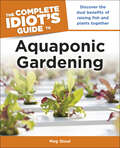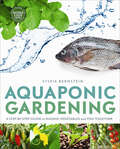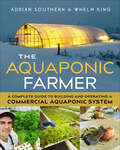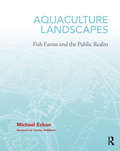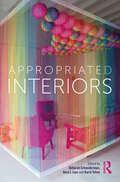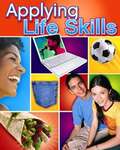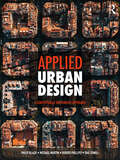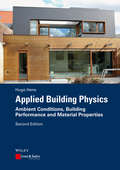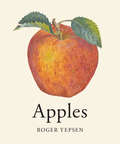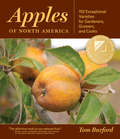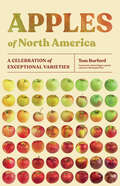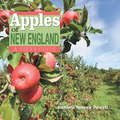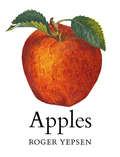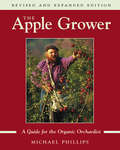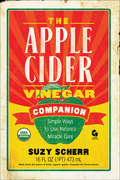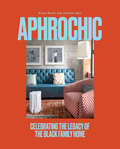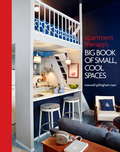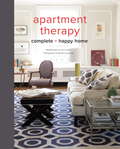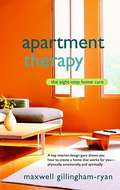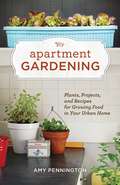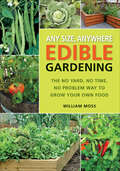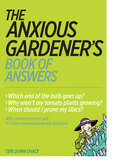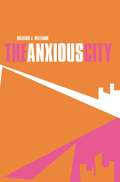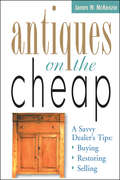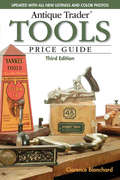- Table View
- List View
Aquaponic Gardening: Discover the Dual Benefits of Raising Fish and Plants Together (Idiot's Guides)
by Meg StoutThe Complete Idiot&’s Guide® to Aquaponic Gardening is a comprehensive guide to aquaponic gardening, from choosing a setup to selecting fish and vegetables. In addition to everything one needs to know to run a healthy aquaponic garden and care for both the vegetables and fish, there are step-by-step plans with photos for building different size systems. The expert author fully explains how to garden indoors and how to resize and move a garden inside or outside, depending on the season, to produce an abundant supply of edible, organically raised vegetables and fish.
Aquaponic Gardening: A Step-by-Step Guide to Raising Vegetables and Fish Together (Mother Earth News Books for Wiser Living)
by Sylvia Bernstein&“I have always wanted to figure out how to do sustainable aquaculture in the context of my home garden. Finally I&’ve got the book to help me do it.&” —Paul Greenberg, New York Times–bestselling author, Four Fish: The Future of the Last Wild Food Aquaponics is a revolutionary system for growing plants by fertilizing them with the waste water from fish in a sustainable closed system. A combination of the best of aquaculture and hydroponics, aquaponic gardening is an amazingly productive way to grow organic vegetables, greens, herbs and fruits, while providing the added benefits of fresh fish as a safe, healthy source of protein. On a larger scale, it is a key solution to mitigating food insecurity, climate change, groundwater pollution and the impacts of overfishing on our oceans.Aquaponic Gardening is the definitive do-it-yourself home manual, focused on giving you all the tools you need to create your own aquaponic system and enjoy healthy, safe, fresh and delicious food all year round. Starting with an overview of the theory, benefits and potential of aquaponics, the book goes on to explain: System location considerations and hardware components The living elements—fish, plants, bacteria, and worms Putting it all together—starting and maintaining a healthy system. Aquaponics systems are completely organic. They are four to six times more productive and use 90 percent less water than conventional gardens. Other advantages include no weeds, fewer pests, and no watering, fertilizing, bending, digging, or heavy lifting—in fact, there really is no down side! Anyone interested in taking the next step towards self-sufficiency will be fascinated by this practical, accessible and well-illustrated guide. &“An excellent primer for anyone considering home-scale aquaculture.&” —Peter Bane, publisher, Permaculture Activist and author, The Permaculture Handbook
The Aquaponic Farmer: A Complete Guide to Building and Operating a Commercial Aquaponic System
by Adrian Southern Whelm King&“The essential guide for people serious about setting up a commercial, cold-water aquaponic system.&” —Dr. Daniel Baker, Department of Fisheries and Aquaculture, Vancouver Island University Profitable cold-water fish and vegetable production. Join the aquaponic farming revolution! Built around a proven 120&’ greenhouse system operable by one person, The Aquaponic Farmer is the game changer that distills vast experience and complete step-by-step guidance for starting and running a cold-water aquaponic farming business—raising fish and vegetables together commercially. Coverage includes: A primer on cold-water aquaponics Pros and cons of different systems Complete design and construction of a Deep Water Culture system Recommended and optional equipment and tools System management, standard operating procedures, and maintenance checklists Maximizing fish and veg production Strategies for successful sales and marketing of fish and plants. As the only comprehensive commercial cold-water resource, The Aquaponic Farmer is essential for farmers contemplating the aquaponics market, aquaponic gardeners looking to go commercial, and anyone focused on high quality food production. Aquaponic farming is the most promising innovation for a sustainable, profitable, localized food system. Until now, systems have largely focused on warm-water fish such as tilapia. A lack of reliable information for raising fish and vegetables in the cool climates of North America and Europe has been a major stumbling block. The Aquaponic Farmer is the toolkit you need. &“Provides almost a step by step cookbook on all pertinent aspects of aquaponics and is based upon the authors&’ experiences from their own successful farm.&” —Michael B. Timmons, PhD & PE, Professor Biological & Environmental Engineering, Cornell University
Aquaculture Landscapes: Fish Farms and the Public Realm
by Michael EzbanAquaculture Landscapes explores the landscape architecture of farms, reefs, parks, and cities that are designed to entwine the lives of fish and humans. In the twenty-first century, aquaculture’s contribution to the supply of fish for human consumption exceeds that of wild-caught fish for the first time in history. Aquaculture has emerged as the fastest growing food production sector in the world, but aquaculture has agency beyond simply converting fish to food. Aquaculture Landscapes recovers aquaculture as a practice with a deep history of constructing extraordinary landscapes. These landscapes are characterized and enriched by multispecies interdependency, performative ecologies, collaborative practices, and aesthetic experiences between humans and fish. Aquaculture Landscapes presents over thirty contemporary and historical landscapes, spanning six continents, with incisive diagrams and vivid photographs. Within this expansive scope is a focus on urban aquaculture projects by leading designers—including Turenscape, James Corner Field Operations, and SCAPE—that employ mutually beneficial strategies for fish and humans to address urban coastal resiliency, wastewater management, and other contemporary urban challenges. Michael Ezban delivers a compelling account of the coalitions of fish and humans that shape the form, function, and identity of cities, and he offers a forward-thinking theorization of landscape as the preeminent medium for the design of ichthyological urbanism in the Anthropocene. With over two hundred evocative images, including ninety original drawings by the author, Aquaculture Landscapes is a richly illustrated portrayal of aquaculture seen through the disciplinary lens of landscape architecture. As the first book devoted to this topic, Aquaculture Landscapes is an original and essential resource for landscape architects, urbanists, animal geographers, aquaculturists, and all who seek and value multispecies cohabitation of a shared public realm.
Appropriated Interiors
by Deborah Schneiderman Anca I. Lasc Karin TehveAppropriated Interiors uncovers the ways interiors participate explicitly and implicitly in embedded cultural and societal values and explores timely emergent scholarship in the fields of interior design history, theory, and practice. What is "appropriate" and "inappropriate" now? These are terms with particular interest to the study of the interior. Featuring thirteen original curated essays, Appropriated Interiors explores the tensions between normative interiors that express the dominant cultural values of a society and interiors that express new, changing, and even transgressive values. With case studies from the late eighteenth century to the twenty-first century, these historians, theorists, and design practitioners investigate the implications of interior design as it relates to politics, gender, identity, spatial abstraction, cultural expression, racial expression, technology, and much more. An informative read for students and scholars of design history and theory, this collection considers the standards, assumptions, codes, and/or conventions that need to be dismantled and how we can expand our understanding of the history, theory, and practice of interior design to challenge the status quo.
Applying Life Skills (Eighth Edition)
by Joan Kelly-Plate Eddye EubanksApplying Life Skills, formerly known as Today's Teen, is a major revision of this hands-on comprehensive Family & Consumer Sciences program. This new edition blends a practical, hands-on approach with a fresh new design, interesting features, and new photographs to enhance readability and promote learning. Students will learn and apply essential life skills.
Applied Urban Design: A Contextually Responsive Approach
by Michael Martin Robert Phillips Philip Black Taki SonbliApplied Urban Design combines 'why' we design and 'who' we design for, with 'how' we design, by providing the reader with a comprehensive and accessible bespoke framework for both understanding and practicing urban design in a contextually responsive manner from appraisal to design delivery. The framework is presented across four distinct steps, covering analysis at strategic and local scales; the urban design program; design development; and technical design. The authors unpack the functional blueprints, liveable qualities, contextual dynamics, and technical components of quality urban design, identifying the role of urban designers in shaping spaces and places across differing local contexts through a responsive and multiscalar approach. International best practice examples and two original ‘live’ case studies in Aalborg, Denmark and Manchester, UK demonstrate the application of the framework across differing scales and contexts – each supported by authors own images and graphics that illustrate the broad range of urban design visualisation techniques and methods.Visually compelling and insightful, Applied Urban Design is for all who seek to understand, demand, and create people-centred, high-quality, contextually responsive places and spaces.
Applied Building Physics: Ambient Conditions, Building Performance and Material Properties
by Hugo S. HensBad experiences with construction quality, the energy crises of 1973 and 1979,complaints about `sick buildings?, thermal, acoustical, visual and olfactory discomfort, the need for good air quality, the move towards more sustainability ? all these have accelerated the development of a field that, for a long time, was hardly more than an academic exercise: building physics. The discipline embraces domains such as heat and mass transfer, building acoustics, lighting, indoor environmental quality and energy efficiency. In some countries, fire safety is also included. Through the application of physical knowledge and its combination with information coming from other disciplines, the field helps to understand the physical phenomena governing building parts, building envelope, whole building and built environment performance, although for the last the wording `urban physics? is used. Building physics has a real impact on performance-based building design. This volume on `Applied Building Physics? discusses the heat, air and moisture performance metrics that affect building design, construction and retrofitting.
Apples (Revised and Updated)
by Roger Yepsen90 beautifully illustrated common and rare apples from the orchards of North America. Roger Yepsen knows his apples. He should, as he is a seasoned orchardist as well as a talented writer and illustrator. Here he presents fascinating facts about 90 mainstay and unusual varieties of apples grown in the United States, from Red Delicious and Granny Smith to Knobbed Russet and Hubbardston Nonesuch. Each entry identifies the variety’s harvest season, unique taste,and best uses, and Yepsen’s beautiful and distinctive watercolors make identification a snap. This new edition has been updated with entries on Honeycrisp and other varieties that have becomes popular since the first publication of Apples in 1994. But this is not just a grower’s catalog. Yepsen also includes a brief history of apples in North America, and recipes for pies, sauces, ciders, and more.
Apples of North America: Exceptional Varieties for Gardeners, Growers, and Cooks
by Tom BurfordAmerican Horticulture Society Award Winner The apple is one of the most iconic fruits, traditionally picked on cool fall days and used in pies, crisps, and ciders. And there is a vast world of varieties that goes beyond the common grocery store offerings of Red Delicious and Granny Smith. With names like American Beauty, Carter’s Blue, and Fallawater, and flavors ranging from sweet to tart, this treasure trove of unique apples is ripe for discovery. There is no better guide through this tasty world than Tom Burford, whose family has grown apples in the Blue Ridge Mountains since 1715. The book is brimming with beautiful portraits of heirloom and modern apples of merit, each accompanied by distinguishing characteristics and common uses. As the view broadens to the orchard, you will find information on planting, pruning, grafting, and more. The exploration of the apple culminates with an overview of the fruit’s transformative capabilities when pressed, fermented, cooked, or dried. Beyond the polished and predictable grocery store display of Red Delicious and Granny Smith apples, a feast of beautiful and uniquely flavored North American varieties awaits the curious.
Apples of North America: A Celebration of Exceptional Varieties
by Tom Burford&“For all of us who cherish the apple, its utility, its flavors, and its powers of revelation and connection.&” —Adrian Higgins, garden columnist, The Washington Post The apple is one of the most iconic fruits, traditionally picked on cool fall days and used in pies, crisps, ciders, and more. And there is a vast world of varieties that goes well beyond the common grocery store offerings. With names like American Beauty, Carter&’s Blue, and Fallawater, and flavors ranging from sweet to tart, this treasure trove of unique apples is ripe for discovery. There is no better guide through this tasty world than Tom Burford, whose family has grown apples in the Blue Ridge Mountains since 1715. His celebratory book Apples of North America is brimming with beautiful portraits of heirloom and modern apples of merit, each accompanied by distinguishing characteristics and common uses. You will also find information on growing apples at home—with specifics on planting, pruning, grafting, and more—and instructions on how to preserve apples through pressing, fermenting, cooking, and drying.
Apples of New England: A User's Guide
by Russell PowellA guide to more than 200 varieties of apples! This fascinating and helpful guide will offer practical advice about rare heirlooms and newly discovered varieties, chapters on the rich tradition of apple growing in New England and on the "fathers" of American apples--Massachusetts natives John Chapman ("Johnny Appleseed") and Henry David Thoreau. Apples of New England will present the apple in all its splendor: as biological wonder, super food, work of art, and cultural icon. Apples of New England will be an indispensable resource for anyone identifying apples in New England orchards, farm stands, grocery stores--or their own backyard. Photographs of the more than 200 apples discovered, grown, or sold in New England will be accompanied by notes about flavor and texture, history, ripening time, storage quality, and best use.
Apples
by Roger YepsenIn this small and elegant book, artist/writer Roger Yepsen presents fascinating facts about more than 200 varieties of apples growing in the United States. With beautiful and distinctive watercolors, he makes identification a snap. He also reveals how each variety tastes and which varieties are best for eating and cooking.
The Apple Grower
by Michael PhillipsThe definitive guide to growing apples wisely, naturally, and with gentle impact on the earth. For decades fruit growers have sprayed their trees with toxic chemicals in an attempt to control a range of insect and fungal pests. Yet it is possible to grow apples responsibly, by applying the intuitive knowledge of our great-grandparents with the fruits of modern scientific research and innovation. Since "The Apple Grower" first appeared in 1998, orchardist Michael Phillips has continued his research with apples, which have been called "organic's final frontier. " In this new edition of his widely acclaimed work, Phillips delves even deeper into the mysteries of growing good fruit with minimal inputs. Some of the cutting edge topics he explores include: bull; The use of kaolin clay as an effective strategy against curculio and borers, as well as its limitations bull; Creating a diverse, healthy orchard ecosystem through understory management of plants, nutrients, and beneficial microorganisms bull; How to make a small apple business viable by focusing on heritage and regional varieties, value-added products, and the "community orchard" model The author's personal voice and clear-eyed advice have already made "The Apple Grower" a classic among small-scale growers and home orchardists. In fact, anyone serious about succeeding with apples needs to have this updated edition on their bookshelf.
The Apple Cider Vinegar Companion: Simple Ways to Use Nature's Miracle Cure
by Suzy ScherrThe multitasking superfood is delicious, too! Generations of devotees have sworn by apple cider vinegar: cooking with it, swigging it by the spoonful, and using it as a remedy for just about any ailment. Why? The tart, fermented flavor certainly can add a punch to any recipe, but it’s also great for weight-loss, digestion, and overall good health. It makes a mean natural cleanser, relieves muscle soreness, and even treats bug bites. The Apple Cider Vinegar Companion is the essential guide, with information on how to make your own, and tips and tricks for using it for household tasks. This book stands out from similar titles because of the wonderful recipes, such as: Dill Pickle Potato Salad Easy Homemade Farmer’s Cheese Homemade Spiced Ketchup Raspberry-Peach Shrub Green Tea and Apple Cider Vinegar Tonic
AphroChic: Celebrating the Legacy of the Black Family Home
by Jeanine Hays Bryan MasonA powerful, visually stunning celebration of Black homeownership, featuring inspiring homes and family histories of notable Black Americans—including chef Alexander Smalls and actor Danielle Brooks.&“The most important design book of our time.&”—Stacey Lindsay, design editor, Camille StylesJeanine Hays and Bryan Mason invite you into the intimate spaces of actors and musicians, the creative studios of artists and curators, the &“boss&” homes of entrepreneurs and executives, &“off-the-beaten-path&” homes that defy the stereotypes of urban living, and places filled with pieces handed down from generations past. Tour the creative and culturally infused Washington, DC, rowhouse of author Jason Reynolds. Take in the bursts of color and layers of memory that fill the Harlem Renaissance–inspired interior of renowned chef Alexander Smalls. And get inspired by the design of actor Danielle Brooks and her husband Dennis Gelin&’s Brooklyn townhome, where Haitian heritage and South Carolina roots meet. Showcasing the amazing diversity of the Black experience through striking interiors, stories of family and community, and histories exploring the obstacles Black homeowners have faced for generations, this groundbreaking book honors the journey, recognizes the struggle, and celebrates the joy that is the Black family home.
Apartment Therapy's Big Book of Small, Cool Spaces
by Maxwell RyanWhether you inhabit a studio or a sprawling house with one challenging space, Maxwell Gillingham-Ryan, co-founder of the most popular interior design website, Apartment Therapy, will help you transform tiny into totally fabulous. According to Maxwell, size constraints can actually unlock your design creativity and allow you to focus on what's essential. In this vibrant book, he shares forty small, cool spaces that will change your thinking forever. These apartments and houses demonstrate hundreds of inventive solutions for creating more space in your home, and for making it more comfortable. Leading us through entrances, living rooms, kitchens and dining rooms, bedrooms, home offices, and kids' rooms, Apartment Therapy's Big Book of Small, Cool Spaces is brimming with ingenious tips and ideas, such as: * Shifting the sense of scale through contrasting colors* Adding airiness by using transparent collections * Utilizing the area under a loft bed for a kitchen and mini-bar * Tucking an office with chic vintage doors into an unused bedroom corner In each dwelling Maxwell points out what makes the layout work and what adds style. Most of the "therapy" involves minor tweaks that can be accomplished on a limited budget, such as dividing a room with sheer curtains, turning a door into a desk, or disguising electrical boxes with art displays. An extensive resource guide, including Maxwell's favorite websites for buying desks, open storage solutions, and much more, will help you turn even the tiniest residence into a place you are always happy to come home to. From the Hardcover edition.
Apartment Therapy Complete and Happy Home
by Maxwell Ryan Melanie Acevedo Janel LabanThe most comprehensive and complete home book from Apartment Therapy, featuring every aspect of design and decorating from floor plans to paint, specific rooms to style approaches, with the goal of setting up and living well in a place you love. "A complete and happy home is so much more than a series of pretty rooms. Between these two covers, we've captured everything we've learned at Apartment Therapy about decorating, organizing, cleaning, and repairs, so you can make and maintain your own fabulous home." --from the IntroductionGetting a room to feel right is more instinct than science. You know a great space when you see it. Apartment Therapy trains your eye with more than 75 rooms, from bedrooms to kitchens and living rooms to kids' rooms and workspaces. Explore every detail--lighting, color palettes, flooring, and accessories--that brings a home to life and, most important, makes you happy in it.
Apartment Therapy: The Eight-Step Home Cure
by Maxwell Gillingham-RyanFrom not enough space and too many things to not knowing what color to paint the living room walls, many of us struggle with our homes. Now Maxwell Gillingham-Ryan, frequent makeover expert on HGTV’s Mission: Organization and Small Spaces, Big Style, shares the do-it-yourself strategies that have enabled his clients and fans to transform their apartments into well-organized, beautiful places that suit their style and budget. Week by week,Apartment Therapywill guide you to treat common problems, eliminate clutter, and revamp even the tiniest space. Here is an eight-step process that includes: A therapeutic questionnaire to help you get in touch with your personal taste and diagnose your home’s physical, emotional, and energy flow issues A prescription with recommendations for each room based on your needs and lifestyle–including tips on how to use color, lighting, and accessories A treatment plan, including regular maintenance schedules to ensure the ongoing health of your space Illustrations of floor plans and decorative examples that allow you to visualize concepts before you begin With surprising ease and without elaborate professional help,Apartment Therapywill help you clear a path through disorder and indecision–to reveal a home you’ll love. From the Trade Paperback edition.
Apartment Gardening: Plants, Projects, and Recipes for Growing Food in Your Urban Home
by Amy PenningtonForget the 100-mile eat-local diet; try the 300-square-foot-diet -- grow squash on the windowsill, flowers in the planter box, or corn in a parking strip. Apartment Gardening details how to start a garden in the heart of the city. From building a window box to planting seeds in jars on the counter, every space is plantable, and this book reveals that the DIY future is now by providing hands-on, accessible advice. Amy Pennington's friendly voice paired with Kate Bingham-Burt's crafty illustrations make greener living an accessible reality, even if readers have only a few hundred square feet and two windowsills. Save money by planting the same things available at the grocery store, and create an eccentric garden right in the heart of any living space.
Any Size, Anywhere Edible Gardening: The No Yard, No Time, No Problem Way To Grow Your Own Food
by William MossFrom the host of HGTV’s Dig In: “If you live in limited quarters, are just starting out, and want to grow most-likely-to-succeed plants, have a read.” —The Philadelphia InquirerEdibles continue to be popular choices for gardeners, and beginning gardeners are no exception. Author William Moss takes a beginning gardener through all the steps needed to grow vegetables and fruits in any setting, regardless of the available (or desired) size. This book covers container gardening, vertical gardening, raised-bed gardening, and traditional methods to help gardeners everywhere bring a taste of homegrown freshness to their gardening experience.“Moss offers ideas for finding space to garden, techniques for creating and maintaining gardens and basic growing information. The bulk of the book, however, is dedicated to details about plants that grow well in compact spaces, with an entire chapter devoted to that all-time favorite, the tomato.” —Akron Beacon Journal“Besides the usual how-to information, Moss offers a chapter that focuses on different types of small gardens, ranging from a container or trellis on a balcony to a small backyard or plot in a community garden.” —Country Gardens Magazine
The Anxious Gardener's Book of Answers
by Teri Dunn ChaceThe Anxious Gardener's Book of Answers identifies the 100 most common gardening mistakes and gives gardeners the techniques to prevent them. Or, if it's too late and they've already goofed, there are tips to fix the mistake. The book's 24 chapters tackle every kind of gardening disaster, whether it has to do with plants, tools and techniques, or general care and maintenance. Gardeners looking to prune their roses will learn to hold off until late winter to avoid damaging plant tissue. Gardeners that have allowed their mint to overgrow? Dunn advises pulling it out and replanting it in a container to control the root. Organized by common garden topics and designed to be easily dipped in and out of, The Anxious Gardener's Book of Answers offers nuggets of wisdom based on Teri Dunn Chace's years of hands-on gardening experience. Advice is humorously supported by Colleen Coover's delightful illustrations. This accessible guide will transform an anxious gardener into an informed, confident, successful gardener with a mistake-free garden
The Anxious City: British Urbanism in the late 20th Century
by Richard J. WilliamsIn the Western world, cities have arguably never been more anxious: practical anxieties about personal safety and metaphysical anxieties about the uncertain place of the city in culture are the small change of journalism and political debate. Cities have long been regarded as problems, in need of drastic solutions. In this context, the contemporary revival of city centres is remarkable. But in a culture that largely fears the urban, how can the contemporary city be imagined? How is it supposed to be used or inhabited? What does it mean? Taking England since WWII as its principal focus, this provocative and original book considers the Western city at a critical moment in its history.
Antiques on the Cheap: A Savvy Dealer's Tips: Buying, Restoring, Selling
by James W. McKenzieGet the inside scoop on every aspect of antiquing - buying, cleaning, repairing, embellishing, refinishing, restoring, and selling. You'll find expert advice for getting great deals at auctions, flea markets, and shops, and you'll learn how to spot items that can be repaired to increase their value. Advice for selling antiques at flea markets, on consignment, and in shops is included.
Antique Trader Tools Price Guide (Antique Trader)
by Clarence BlanchardThe Most Valuable Tool in Your Toolbox Lacking the edge on tool information? Cut through the competition and hammer home deals like a pro with Antique Trader Tools Price Guide. Featuring 700 color photos, thousands of listings with current values, market trends, and collecting advice, it's the definitive reference on antique tools. This book features:700 color photos, with actual prices received at auctions 2,000 listings covering planes, braces, drills, saws, hammers, levels, rules, squares, gauges, scientific instruments, patented tools, advertising, and much more Information on building a collection, condition grading, market trends, and investing New!Chapter on collecting Stanley tools Condition grading photos
